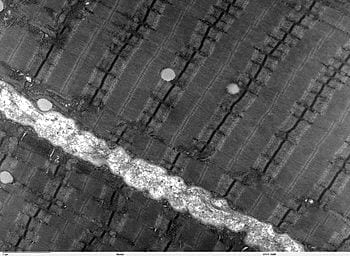
In a new study that could ultimately lead to many new medicines, scientists from the Florida campus of The Scripps Research Institute (TSRI) have adapted a chemical approach to turn diseased cells into unique manufacturing sites for molecules that can treat a form of muscular dystrophy.
“We’re using a cell as a reaction vessel and a disease-causing defect as a catalyst to synthesize a treatment in a diseased cell,” said TSRI Professor Matthew Disney. “Because the treatment is synthesized only in diseased cells, the compounds could provide highly specific therapeutics that only act when a disease is present. This means we can potentially treat a host of conditions in a very selective and precise manner in totally unprecedented ways.”
The promising research was published recently in the international chemistry journal Angewandte Chemie.
Targeting RNA Repeats
In general, small, low molecular weight compounds can pass the blood-brain barrier, while larger, higher weight compounds tend to be more potent. In the new study, however, small molecules became powerful inhibitors when they bound to targets in cells expressing an RNA defect, such as those found in myotonic dystrophy.
Myotonic dystrophy type 2, a relatively mild and uncommon form of the progressive muscle weakening disease, is caused by a type of RNA defect known as a “tetranucleotide repeat,” in which a series of four nucleotides is repeated more times than normal in an individual’s genetic code. In this case, a cytosine-cytosine-uracil-guanine (CCUG) repeat binds to the protein MBNL1, rendering it inactive and resulting in RNA splicing abnormalities that, in turn, results in the disease.
In the study, a pair of small molecule “modules” the scientists developed binds to adjacent parts of the defect in a living cell, bringing these groups close together. Under these conditions, the adjacent parts reach out to one another and, as Disney describes it, permanently hold hands. Once that connection is made, the small molecule binds tightly to the defect, potently reversing disease defects on a molecular level.
“When these compounds assemble in the cell, they are 1,000 times more potent than the small molecule itself and 100 times more potent than our most active lead compound,” said Research Associate Suzanne Rzuczek, the first author of the study. “This is the first time this has been validated in live cells.”
The Latest on: Specific therapeutics
[google_news title=”” keyword=”Specific therapeutics” num_posts=”10″ blurb_length=”0″ show_thumb=”left”]
via Google News
The Latest on: Specific therapeutics
- Cidara Therapeutics: Now Well-Funded To Advance Its Cloudbreak Platformon April 26, 2024 at 3:02 pm
Cidara Therapeutics, Inc. secures funding and focuses on oncology platform after passing rezafungin rights to Mundipharma. Learn more about CDTX stock here.
- PTCT Stock Earnings: PTC Therapeutics Beats EPS, Beats Revenue for Q1 2024on April 25, 2024 at 9:56 pm
PTCT stock results show that PTC Therapeutics beat analyst estimates for earnings per share and beat on revenue for the first quarter of 2024.More From InvestorPlace The #1 AI Investment Might Be This ...
- ASCO, CAP Call on Manufacturers to Adopt Therapeutic Group Labelingon April 25, 2024 at 11:32 am
Therapeutic Group Labeling Will Improve Access, Simplify Clinical Practices, Enhance Diagnostic Efficiency Northfield, Ill. (April 25, 2024) — The American Society ...
- Acrivon Therapeutics: Strong Buy on Impressive Clinical Outcomes and Market Potentialon April 25, 2024 at 9:46 am
In a report released today, Soumit Roy from JonesTrading reiterated a Buy rating on Acrivon Therapeutics, Inc. (ACRV – Research Report), ...
- SpringWorks Therapeutics Announces Abstracts Accepted for Presentation at the 2024 American Society of Clinical Oncology (ASCO) Annual Meetingon April 24, 2024 at 11:26 am
Results from Phase 2b ReNeu trial of mirdametinib in NF1-PN accepted for oral presentation –– Additional data from the Phase 3 DeFi trial of ...
- Crispr Therapeutics: Now Is The Time To Buyon April 24, 2024 at 9:40 am
Despite recent FDA approvals for gene editing technology, CRISPR Therapeutics' stock declined. Click here to read an analysis of CRSP stock now.
- Amicus Therapeutics gets grant for treatment of fabry disease with migalastat for specific mutationson April 24, 2024 at 6:10 am
Discover Amicus Therapeutics' groundbreaking patent for treating Fabry disease with migalastat, targeting specific mutations in a-galactosidase A. Learn about the innovative method and potential ...
- A new method for enzymatic synthesis of potential RNA therapeuticson April 23, 2024 at 9:10 am
A team of researchers at IOCB Prague led by Prof. Michal Hocek has developed a novel method for preparing ribonucleic acid (RNA) containing modified bases. Innovative use of engineered DNA polymerases ...
- Allogene Therapeutics gets grant for patent granted for CD19-specific CARS resistant to rituximabon April 23, 2024 at 5:50 am
Discover the groundbreaking patent by Allogene Therapeutics for CD19-specific CARs resistant to rituximab binding. Learn about the innovative methods and features of these engineered immune cells.
- What made Windtree Therapeutics stock tank 20% on Monday?on April 22, 2024 at 8:08 am
Windtree Therapeutics stock recently went through a reverse split. $WINT also reported its quarterly financial results last week.
via Bing News









